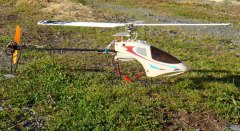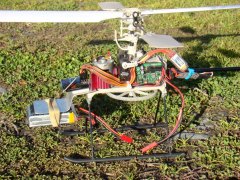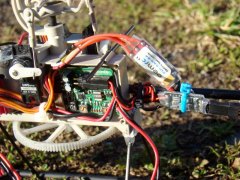 |
GWS Mini Dragonfly |
| Rotor span |
530mm (21") |
| Disc Loading |
12.7g/dm2 (4.2oz/sqft) |
| Flying Weight |
280g (9.9oz) |
| Main Blades |
Extreme Production 255mm 10° Wood Blades (fixed pitch) |
| Tail Rotor |
GWS EP5030 |
| Main Motor |
GWS EM300H |
| Tail Motor |
HXT D2211-1700 |
| Speed Controllers |
GWS PHA-01, Hobbywing Pentium 6A |
| Battery |
Flightpower 850mAh 2S 25C (7.4V) |
| Receiver |
Spektrum AR6100 |
| Servos |
2x GWS Naro STD |
| Controls |
Aileron, Elevator, Motor, Rudder |
| Construction |
Composite |
This is one of the first GWS Mini Dragonfly fixed pitch helis ever produced, but with several upgrades and
enhancements! When I acquired it both motors were worn out, and the tail assembly, servos, gyro and mixer-speed
control board were missing. I added a GWS PHA-01 "3-in-1" controller with integrated gyro, GWS Naro STD servos,
and a direct drive brushed tail motor+fin. I also made an aluminum bracket at the front to hold a 2S Lipo battery
(the original 7 cell NiMH pack was mounted between the skids).
I flew with this setup for several hundred flights, wearing out a few tail motors and the brushes on the main
motor once. Of course I also went through several sets of blades, booms, skids, links etc. while learning to fly!
However the main frame and most of the head mechanism are still original - amazing that it has lasted so well and
is not yet worn out...
With original parts now becoming had to get, and the hassle of having to replace the tail motor regularly, I
decided to try putting a brushless motor on the tail. The HXT 2211-1700Kv fitted perfectly
with it's bearing tube pressed into the tail fin's drive shaft hole, and weight was the same as with the original CN12
brushed motor. I secured the GWS 5x3 inch prop onto the 2mm motor shaft with a GWS AD001 press-fit rubber prop adapter.
To connect the 3 motor wires to the ESC I used 24g servo wire, which just fitted though the inside of the carbon fibre
tail boom.
The gyro in the PHA-01 controls the speed of the tail motor via an integrated brushed ESC, but my 6A brushless
ESC requires a servo pulse signal. To generate a servo signal from the motor output I used an Extreme Production
Brushed to Brushless Converter. However this unit is only designed for main motors, and it had some problems.
Firstly it was very sluggish to respond to speed changes, so the tail hunted badly even with the gyro gain turned
right down. Secondly, with full rudder it would stop producing a signal and the brushless ESC would shut down.
To get around these issues I reprogrammed the converter with my own firmware,
which has no delay and sends pulses at 100Hz to improve ESC throttle response. It now holds the tail steady and has good
response with gyro gain set to about 60%.
As well as not having to worry about burning out motors, the brushless setup is much more efficient. Current draw is
lower so I can now use a smaller battery. The brushless motor stays cool, whereas the brushed motor would get scolding
hot in warm weather. With the brushed motor I had to add a click of rudder trim every minute while flying, to compensate
for reduced power as the motor heated up. Now it needs no trim adjustment at all!
I upgraded to narrower wooden blades at the same time, and they also seem to be more efficient than the stock plastic
blades. These blades are flat-bottomed rather than under-cambered, which appears to help them avoid 'ballooning' in wind
gusts. The only downside is that the blade tips are quite delicate. I put clear tape over the tips to stop the covering
from splitting if a blade strike occurs on takeoff or landing (my skids have a narrower stance than normal because I had
to drill extra holes in the frame after the original skids broke off, so the heli can easily fall over on rough ground).
The final upgrade I did was putting on an ESky Honeybee CP2 canopy. It is surprising how much easier a heli can be to
fly when it has a more distinctive body. The translucent smoked plastic windscreen and brightly-coloured decals on this
body help with orientation, and I no longer tend to lose track of the heli's direction at certain angles. It is also a
bit longer, which not only improves visibility but also provides more room for the battery.



Back



